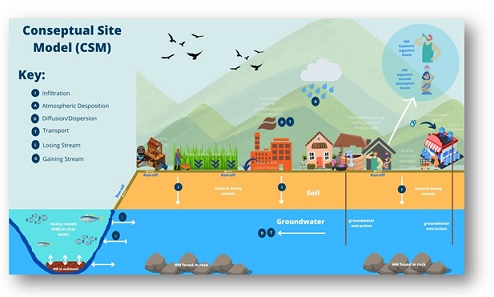Document Type : ORIGINAL RESEARCH ARTICLE
Authors
1 Department of Environmental Engineering, Institut Teknologi Bandung, Jalan Ganesha 10, Bandung 40132, West Java, Indonesia
2 Environmental Management Technology Research Group, Department of Environmental Engineering, Institut Teknologi Bandung, Jalan Ganesha 10, Bandung 40132, West Java, Indonesia
3 Industrial Hygiene and Technology Laboratory, Institut Teknologi Bandung, Jalan Ganesha 10, Bandung 40132, West Java, Indonesia
Abstract
BACKGROUND AND OBJECTIVES: Excessive presence of heavy metals in water sources can reduce water quality and harm human health. However, research on heavy metals from water sources for sanitation and hygiene purposes and drinking water in the Upper Citarum Watershed remains limited. This study focuses on the distribution of heavy metals and chemicals that have potential health risks.
METHODS: Ten heavy metals, namely, lead, cadmium, chromium, copper, cobalt, iron, mercury, manganese, arsenic, and zinc, were analyzed. Groundwater samples were collected from 160 locations, and drinking water samples (for respondents who do not drink groundwater) were collected from 98 locations. Heavy metal concentrations were detected using inductively coupled plasma optical emission spectrometry.
FINDINGS: The levels of arsenic, cadmium, cobalt, iron, mercury, manganese, and lead exceeded the quality standards for drinking water, while those of arsenic and cobalt did not exceed the quality standards for water hygiene and sanitation. Arsenic and cobalt quality standards were more stringent for drinking water compared with those for water hygiene and sanitation. Lead–cadmium and iron–manganese in groundwater showed a positive Spearman correlation (p<0.05) and may originate from the same source. Copper and zinc did not exceed the quality standard in 100% of drinking water samples. Iron and zinc in groundwater differed significantly due to variations in topography and soil type (p<0.05). This study reveals that 6 out of 10 heavy metals are chemicals of potential concern and are sorted based on potential risks to health, that is, arsenic > mercury > lead > cobalt > manganese > cadmium. Ingestion is the main pathway for potential risk, and children are more likely to be at risk than adults.
CONCLUSION: Stakeholders and decision makers must immediately implement sustainable actions to protect public health. Evaluation of water sources, technology, maintenance processes, and water quality should be conducted before and after technology use from Refill Drinking Water Depots to ensure that raw and processing water meets the quality standards.
Graphical Abstract
Highlights
- About 46% and 27% of the consumption water samples contained As and Pb levels higher than the maximum limit;
- Chemicals of potential concerns were studied by comparing the value of risk-based concentration.
- The six heavy metals that were proven to be COPCs were As > Hg > Pb > Co > Mn > Cd;
- No potential health risk was detected from using water containing six COPCs for sanitation and hygiene, but potential health risks were found from consuming water.
Keywords
- Chemical of potential concerns (COPCs)
- Drinking water
- Groundwater
- Health risk
- Hygiene and sanitation
- Spatial distribution
Main Subjects
OPEN ACCESS
©2023 The author(s). This article is licensed under a Creative Commons Attribution 4.0 International License, which permits use, sharing, adaptation, distribution and reproduction in any medium or format, as long as you give appropriate credit to the original author(s) and the source, provide a link to the Creative Commons license, and indicate if changes were made. The images or other third party material in this article are included in the article’s Creative Commons license, unless indicated otherwise in a credit line to the material. If material is not included in the article’s Creative Commons license and your intended use is not permitted by statutory regulation or exceeds the permitted use, you will need to obtain permission directly from the copyright holder. To view a copy of this license, visit:
http://creativecommons.org/licenses/by/4.0/
PUBLISHER NOTE
GJESM Publisher remains neutral concerning jurisdictional claims in published maps and institutional affiliations.
CITATION METRICS & CAPTURES
Google Scholar | Scopus | Web of Science | PlumX Metrics | Altmetrics | Mendeley |
CURRENT PUBLISHER
GJESM Publisher



Letters to Editor
[1] Letters that include statements of statistics, facts, research, or theories should include appropriate references, although more than three are discouraged.
[2] Letters that are personal attacks on an author rather than thoughtful criticism of the author’s ideas will not be considered for publication.
[3] Letters can be no more than 300 words in length.
[4] Letter writers should include a statement at the beginning of the letter stating that it is being submitted either for publication or not.
[5] Anonymous letters will not be considered.
[6] Letter writers must include their city and state of residence or work.
[7] Letters will be edited for clarity and length.
Send comment about this article